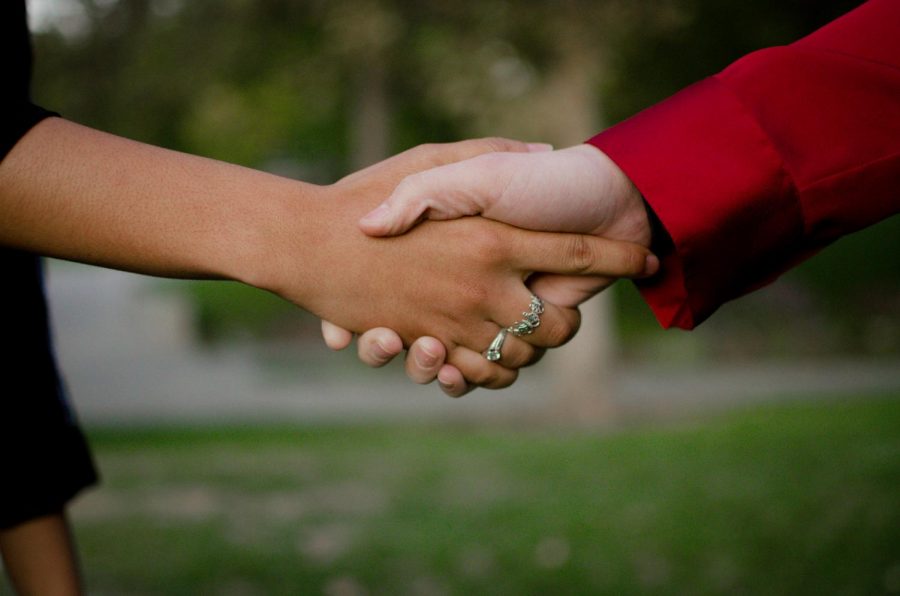Salt Lake Temporary Winter Housing Hopes to Change Public Perspective of Homelessness
Friends come together in spite of the world’s current events on campus in Salt Lake City. (Photo by Maya Fraser | The Daily Utah Chronicle)
February 8, 2021
The Salt Lake Temporary Winter Housing located at the Airport Inn Emergency Shelter provides a roof to those without a home, and it also provides a space for people suffering from homelessness to use resources and try to make a better life for themselves so that they may eventually have all of these things.
Salt Lake City winters are characterized by cold weather and snow. As a way of combatting freezing temperatures and unliveable conditions, overflow shelters — like the Airport Inn Emergency Shelter — spring up every winter.
The Airport Inn Shelter, run by Switchpoint Community Resource Center, provides beds to 150 people that couldn’t be accommodated at other local Homeless Resource Centers, and they offer a special addition — rooms for couples like April Jones and Derek St. Clair, who have been staying there since Jan. 5.
“Connections and human relationships are the most important thing to most of us, but especially when you have nothing else. That is all that’s important to you,” said Carol Hollowell, executive director of Switchpoint and a leader at the Airport Inn Shelter.
With 34 rooms set aside for couples, people who stayed on the street in order to avoid being separated from a partner find a solution.
Jones and St. Clair are one of these couples. Due to losing work and the rising cost of living driven by people moving to Salt Lake City, they were priced out of their homes. St. Clair became homeless in May, while Jones became homeless in September, though neither due to the COVID-19 pandemic. They met while homeless and have been together for about five months.
Their tent and belongings were taken during the recent Rio Grande cleanup, despite being “the only one where nobody did drugs,” according to St. Clair. They were left with no option but to go to Catholic Community Services, where according to them, they were forced outside every day due to COVID-19 restrictions, surrounded by drugs and squalid living conditions. The couple made contact with street outreach workers from Volunteers of America, who told them about the Airport Inn Shelter.
The shelter filled up in three days but they arrived in time to get a couple’s room, which they said was the main reason they came.
Out of all the shelters that they have stayed at, the Airport Inn is by far their favorite, due in large part to the “friendly and warm and kind and helpful” staff, led by Hollowell.
Walking into the lobby of the shelter, Hollowell can be found dancing with volunteers or handing out plates of food with a huge smile on her face.
Unlike other shelters in Salt Lake City, the individual rooms of the Airport Inn allow the residents to stay inside during the day to avoid cold and dangerous environments in a COVID-19-friendly manner. Hollowell hopes that this concept could transition into some sort of affordable housing for residents, as “at least 80% of these people have some kind of income, and they could pay rent, they just have been priced out of the market.”
Rather than creating another emergency shelter like the Airport Inn for next winter, she hopes that the Salt Lake Valley Coalition to End Homelessness and other community outreach groups will be able to create “300 beds in apartments or homes that are affordable to these people” rather than 300 beds in another shelter.
Inspired by reluctance from business owners to offer their property, she hopes to change the perception of people suffering from homelessness with a positive model in the Airport Inn. This shelter does not tolerate the destruction of property or drug use, but instead of kicking addicts out, it offers resources for people who may not have had access to rehab or other programs in the past.
“We find that if we treat people with dignity, they act with dignity,” Hollowell said.
St. Clair and Jones are hopeful that this goal will be reached by April, when the Airport Inn Shelter is set to close for the summer. They want to avoid going back to the street at all costs, which is a strong possibility without some sort of replacement home in which they can be together.
In the meantime, they, and many other couples, have found solace in the Airport Inn Emergency Shelter. To continue providing residents with the best shelter possible, donations and volunteers are welcome. Items like toilet paper, hand sanitizer and plastic gloves are appreciated contributions, and so are volunteers to help serve meals. People can help by visiting switchpointcrc.org and going to the “Ways to Help” tab.
This article has been updated in both the title and first mention of the Airport Inn to reference Salt Lake Temporary Winter Housing. There are multiple Salt Lake Temporary Housing facilities, and Airport Inn is the location of one of the shelters, mentioned here.







